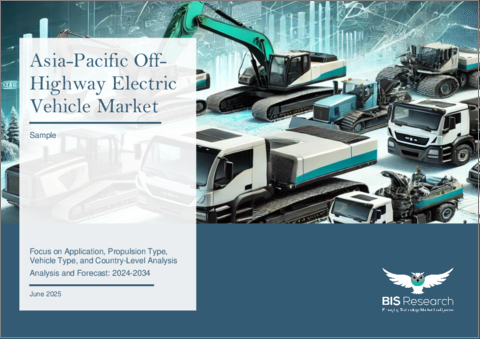|
|
市場調査レポート
商品コード
1743356
アジア太平洋のオフハイウェイ電気自動車市場:用途別、推進タイプ別、車両タイプ別、国別 - 分析と予測(2024年~2034年)Asia-Pacific Off-Highway Electric Vehicle Market: Focus on Application, Propulsion Type, Vehicle Type, and Country-Level Analysis - Analysis and Forecast, 2024-2034 |
||||||
カスタマイズ可能
|
|||||||
| アジア太平洋のオフハイウェイ電気自動車市場:用途別、推進タイプ別、車両タイプ別、国別 - 分析と予測(2024年~2034年) |
|
出版日: 2025年06月06日
発行: BIS Research
ページ情報: 英文 76 Pages
納期: 1~5営業日
|
- 全表示
- 概要
- 図表
- 目次
アジア太平洋のオフハイウェイ電気自動車の市場規模は、2024年の18億3,490万米ドルから2034年には208億7,070万米ドルに成長すると予測され、予測期間の2024年~2034年のCAGRは27.52%と堅調な伸びを示すとみられています。
中国、インド、東南アジアでは、鉱業、建設、農業における電気機器の使用が拡大しているため、アジア太平洋のオフハイウェイ電気自動車(EV)市場は急速に成長しています。より厳しい公害規制を遵守し、長期的なランニングコストを削減するため、企業は電動代替車両への切り替えを進めています。車両性能、充電インフラ、バッテリー効率の技術開発により、オフハイウェイ用電動機器の実現可能性と魅力が大幅に高まっています。一方、公共部門と商業部門は、政府の排出規制、グリーン調達戦略、企業のESG義務により、よりクリーンな産業慣行へと移行しています。オフハイウェイEVは、各国の脱炭素化目標や持続可能性目標が加速する中、アジア太平洋の持続可能な産業用モビリティへのシフトにおいて重要な役割を果たすと考えられます。
市場イントロダクション
| 主要市場統計 | |
|---|---|
| 予測期間 | 2024年~2034年 |
| 2024年の評価 | 18億3,490万米ドル |
| 2034年の予測 | 208億7,070万米ドル |
| CAGR | 27.52% |
アジア太平洋のオフハイウェイ電気自動車(OHEV)市場は、エンドユーザー、企業、政府がディーゼルエンジン駆動の機械に代わる、よりクリーンで効果的な代替品を求めていることから拡大しています。特に中国、インド、日本、東南アジアでは、電動トラクター、ローダー、フォークリフト、その他の特殊機械を含むOHEVが、燃料価格、排出基準、労働衛生に対する懸念の高まりに対応しています。特に鉱業、建設、倉庫業、農業などの業界では、急速な都市化とインフラ構想により、電動ソリューションのニーズが高まっています。
中国の農村電化構想やインドのFAME奨励金のような、初期費用を削減し現地生産を促進する支援政策は、重要な動機付けとなっています。バッテリー化学物質(特にリチウムイオンとLFP)の技術的進歩と充電ネットワークの拡大により、信頼性と運転可能範囲が拡大します。フリートオペレーターが総所有コストと企業の持続可能性誓約の利点を認識するようになり、製造パーク、物流センター、広大なプランテーションからの需要によって、採用はさらに加速されます。
しかし、地方における適切な充電インフラの不足、ディーゼル代替燃料よりも高い建設コスト、熟練したメンテナンス作業員の不足などの問題が、拡大を抑制する可能性があります。こうした障害を回避するため、市場参入企業はアフターセールス・サポート・ネットワークに投資したり、地域の組立メーカーと提携したりしています。今後5年間は、政府支援の強化、バッテリー技術の進歩、環境意識の高まりにより、OHEVの力強い展開が予想され、アジア太平洋は卓越したオフハイウェイ電化地域となります。
市場セグメンテーション
セグメンテーション1:用途別
- 建設
- 鉱業
- 農業
- その他
セグメンテーション2:推進力タイプ別
- バッテリー電気自動車(BEV)
- ハイブリッド電気自動車(HEV)
セグメンテーション3:車両タイプ別
- 掘削機
- トラック
- ローダー
- その他(トラクター、スノーグルーミングなど)
セグメンテーション4:地域別
- アジア太平洋地域
アジア太平洋地域のオフハイウェイ電気自動車(OHEV)市場動向と促進要因・課題
動向
- 農業と建設での採用:電動トラクター、ローダー、その他のオフハイウェイ機器は、特に中国とインドで、メーカーがバッテリー駆動モデルを導入するにつれて牽引力を増しています。
- 電動マテリアルハンドリングの出現:東南アジアの倉庫・物流部門では、屋内の空気の質を改善するため、電動フォークリフトやその他のマテリアルハンドリング車の使用が増加しています。
- パートナーシップと現地生産:OEMは、タイやベトナムなどの市場で現地組立業者と協力し、地域のニーズに合わせたコスト効率の高いOHEVソリューションを開発しています。
- バッテリー技術の進歩:エネルギー密度の向上と充電速度の高速化により、オフハイウェイ用途での長時間稼働が可能になり、より広範な商業化が推進されています。
促進要因
- 厳しい排出規制:中国の積極的なカーボンニュートラル目標やインドのクリーンな農機具の推進は、電動オフハイウェイ・ソリューションへの投資を促しています。
- 総所有コスト(TCO)の削減:鉱業やロジスティクスなどの分野では、資産のライフサイクルにおける燃料費とメンテナンスコストの削減がエンドユーザーにアピールしています。
- 政府のインセンティブと補助金:電気トラクターに対する補助金(インドのFAMEスキームなど)や、オーストラリアの持続可能な機器に対する減税措置は、OHEVの採用を加速させます。
- 企業の持続可能性目標:アジア太平洋の大規模なプランテーション、鉱山、建設会社は、ネット・ゼロオペレーションを目標としており、電動重機を選好しています。
課題
- 初期資本コストの高さ:特に価格に敏感な市場では、ディーゼル車と比較して割高な価格設定が中小企業の足かせとなっています。
- 充電インフラ格差:遠隔地の作業現場で急速充電ステーションを利用できる場所が限られているため、電動オフハイウェイ・フリートが事業を継続する上で障害となります。
- バッテリーの耐久性と性能:鉱山や建設現場での過酷な使用条件(粉塵、振動、極端な温度)により、バッテリーの寿命と信頼性が試されます。
- 熟練技術者の不足:高電圧システムとリチウムイオンバッテリーの整備訓練を受けた技術者が地域全体で不足しており、アフターサービスとメンテナンスが遅れています。
製品/イノベーション戦略:当レポートは、アジア太平洋のオフハイウェイ電気自動車市場における包括的な製品・イノベーション戦略を提供し、市場参入の機会、技術的進歩、持続可能な実践に焦点を当てています。企業が二酸化炭素削減目標を達成し、さまざまな分野で増大するオフハイウェイ電気自動車の需要を活用するための実用的な洞察を提供します。
成長/マーケティング戦略:当レポートでは、アジア太平洋のオフハイウェイ電気自動車市場に特化した強固な成長・マーケティング戦略を概説しています。ニッチ市場セグメントの特定、競合優位性の確立、市場シェアと財務実績を最適化する革新的マーケティング施策の実施など、的を絞ったアプローチを強調しています。これらの戦略的提言を活用することで、企業は市場でのプレゼンスを強化し、新たな機会を開拓し、効率的に収益成長を推進することができます。
競合戦略:当レポートは、アジア太平洋のオフハイウェイ電気自動車市場向けに設計された強力な競争戦略を策定しています。主要市場参入企業を評価し、差別化戦術を提案し、競争力を維持するための指針を提供します。これらの戦略的指示に従うことで、企業は競合他社に対して効果的なポジションを確立し、急速に進化する市場での長期的な成功と収益性を確保することができます。
主要市場参入企業と競合情勢
アジア太平洋のオフハイウェイ電気自動車市場でプロファイルを作成している企業は、主要な専門家から収集した情報、企業のカバレッジ、プロジェクトポートフォリオ、市場浸透度の分析に基づいて選定しています。
当レポートでは、アジア太平洋のオフハイウェイ電気自動車市場について調査し、市場の概要とともに、用途別、推進タイプ別、車両タイプ別、国別の動向、および市場に参入する企業のプロファイルなどを提供しています。
目次
エグゼクティブサマリー
第1章 市場
- 動向:現状と将来への影響評価
- サプライチェーンの概要
- R&Dレビュー
- ステークホルダー分析
- 市場力学の概要
- ディーゼルと電気のオフハイウェイ車両の包括的な分析
- オフハイウェイ車両市場の電動化の将来動向、2023年~2030年
- オンハイウェイとオフハイウェイの電動化の新たな類似点
第2章 地域
- 地域サマリー
- アジア太平洋
- 地域概要
- 市場成長促進要因
- 市場成長抑制要因
- 用途
- 製品
- アジア太平洋(国別)
第3章 市場-競合ベンチマーキングと企業プロファイル
- 今後の見通し
- 地理的評価
- Hitachi Construction Machinery Co., Ltd.
- Sany Group
- Komatsu Ltd.
第4章 調査手法
List of Figures
- Figure 1: Asia-Pacific Off-Highway Electric Vehicle Market (by Scenario), $Million, 2024, 2027, and 2034
- Figure 2: Asia-Pacific Off-Highway Electric Vehicle Market (by Application), $Million, 2023, 2027, and 2034
- Figure 3: Asia-Pacific Off-Highway Electric Vehicle Market (by Propulsion Type), $Million, 2023, 2027, and 2034
- Figure 4: Asia-Pacific Off-Highway Electric Vehicle Market (by Vehicle Type), $Million, 2023, 2027, and 2034
- Figure 5: Key Events
- Figure 6: Failure Rate of Batteries, 2011-2023
- Figure 7: Number of Mining Fatalities, 2010-2023
- Figure 8: Supply Chain and Risks within the Supply Chain
- Figure 9: Value Chain of Off-Highway Electric Vehicle Market
- Figure 10: Off-Highway Electric Vehicle Market, by Vehicle Type, ($US/Unit), 2023, 2027, and 2034
- Figure 11: Patent Analysis (by Country), 2021-December 2024
- Figure 12: Patent Analysis (by Company), January 2021-February 2025
- Figure 13: End User and Buying Criteria in the Off-Highway Electric Vehicle Market
- Figure 14: Impact Analysis of Market Navigating Factors, 2023-2034
- Figure 15: Estimated Annual Emission (by Vehicle Type)
- Figure 16: Announced Electric Vehicle Battery Manufacturing Capacity by Region and Manufacturing Capacity Needed in The Net Zero Scenario, 2025 and 2030
- Figure 17: Mining Energy Intensity, Ventilation, and Cooling (by Energy Type), MJ/Ton
- Figure 18: Performance Comparison when Loaded (by Vehicle Type)
- Figure 19: Total Cost of Ownership, Net Present Cost ($), 2023
- Figure 20: Total Cost of Ownership Savings, Percentage (%)
- Figure 21: On-Highway vs. Off-Highway Compound Annual Growth Rate, Percentage, 2024-2034
- Figure 22: Share of Battery Electric Vehicles of All Vehicle Sales
- Figure 23: China Off-Highway Electric Vehicle Market, $Million, 2023-2034
- Figure 24: Japan Off-Highway Electric Vehicle Market, $Million, 2023-2034
- Figure 25: South Korea Off-Highway Electric Vehicle Market, $Million, 2023-2034
- Figure 26: Rest-of-Asia-Pacific Off-Highway Electric Vehicle Market, $Million, 2023-2034
- Figure 27: Strategic Initiatives, January 2022-February 2025
- Figure 28: Share of Strategic Initiatives, 2023
- Figure 29: Data Triangulation
- Figure 30: Top-Down and Bottom-Up Approach
- Figure 31: Assumptions and Limitations
List of Tables
- Table 1: Market Snapshot
- Table 2: Opportunities across Region
- Table 3: Competitive Landscape Snapshot
- Table 4: Future Outlook
- Table 5: Regulatory Landscape
- Table 6: Country-Wise Targets
- Table 7: Electrification Rate (by Vehicle Type), 2023 and 2030
- Table 8: Off-Highway Electric Vehicle Market (by Region), $Million, 2023-2034
- Table 9: Asia-Pacific Off-Highway Electric Vehicle Market (by Application), $Million, 2023-2034
- Table 10: Asia-Pacific Off-Highway Electric Vehicle Market (by Propulsion Type), $Million, 2023-2034
- Table 11: Asia-Pacific Off-Highway Electric Vehicle Market (by Vehicle Type), $Million, 2023-2034
- Table 12: China Off-Highway Electric Vehicle Market (by Application), $Million, 2023-2034
- Table 13: China Off-Highway Electric Vehicle Market (by Propulsion Type), $Million, 2023-2034
- Table 14: China Off-Highway Electric Vehicle Market (by Vehicle Type), $Million, 2023-2034
- Table 15: Japan Off-Highway Electric Vehicle Market (by Application), $Million, 2023-2034
- Table 16: Japan Off-Highway Electric Vehicle Market (by Propulsion Type), $Million, 2023-2034
- Table 17: Japan Off-Highway Electric Vehicle Market (by Vehicle Type), $Million, 2023-2034
- Table 18: South Korea Off-Highway Electric Vehicle Market (by Application), $Million, 2023-2034
- Table 19: South Korea Off-Highway Electric Vehicle Market (by Propulsion Type), $Million, 2023-2034
- Table 20: South Korea Off-Highway Electric Vehicle Market (by Vehicle Type), $Million, 2023-2034
- Table 21: Rest-of-Asia-Pacific Off-Highway Electric Vehicle Market (by Application), $Million, 2023-2034
- Table 22: Rest-of-Asia-Pacific Off-Highway Electric Vehicle Market (by Propulsion Type), $Million, 2023-2034
- Table 23: Rest-of-Asia-Pacific Off-Highway Electric Vehicle Market (by Vehicle Type), $Million, 2023-2034
- Table 24: Market Share
Introduction to Asia-Pacific Off-Highway Electric Vehicle Market
The Asia-Pacific off-highway electric vehicle market is projected to grow from $1,834.9 million in 2024 to $20,870.7 million by 2034, showing a robust CAGR of 27.52% during the forecast period 2024-2034. Due to the growing use of electric equipment in mining, construction, and agriculture in China, India, and Southeast Asia, the off-highway electric vehicle (EV) market in Asia-Pacific is growing quickly. In order to comply with more stringent pollution regulations and reduce their long-term running expenses, businesses are switching to electric alternatives. Technological developments in vehicle performance, charging infrastructure, and battery efficiency have greatly increased the viability and attractiveness of electric off-highway equipment. Meanwhile, the public and commercial sectors are moving towards cleaner industrial practices due to government emissions laws, green procurement strategies, and corporate ESG obligations. Off-highway EVs are positioned to play a key role in APAC's shift to sustainable industrial mobility as national decarbonisation ambitions and sustainability targets pick up speed.
Market Introduction
| KEY MARKET STATISTICS | |
|---|---|
| Forecast Period | 2024 - 2034 |
| 2024 Evaluation | $1,834.9 Million |
| 2034 Forecast | $20,870.7 Million |
| CAGR | 27.52% |
The market for off-highway electric vehicles (OHEVs) in the Asia-Pacific region is expanding as end users, businesses, and governments look for cleaner, more effective substitutes for diesel-powered machinery. Particularly in China, India, Japan, and Southeast Asia, OHEVs-which include electric tractors, loaders, forklifts, and other specialised machinery-address growing concerns about fuel prices, emission standards, and occupational health. The need for electric solutions has increased due to rapid urbanisation and infrastructure initiatives, particularly in industries like mining, construction, warehousing, and agriculture.
Supportive policies that reduce upfront costs and promote local production, like China's rural electrification initiatives and India's FAME incentives, are important motivators. Reliability and operational range are increased by technological advancements in battery chemistries (particularly lithium-ion and LFP) and growing charging networks. Adoption is further accelerated by demand from manufacturing parks, logistics centres, and expansive plantations as fleet operators become aware of the advantages of total cost of ownership and corporate sustainability pledges.
Problems including a lack of adequate charging infrastructure in rural locations, greater construction costs than diesel alternatives, and a lack of skilled maintenance workers, however, may restrain expansion. To get around these obstacles, market participants are investing in after-sales support networks and forming alliances with regional assemblers. Strong OHEV deployment is anticipated over the next five years due to increased government support, ongoing battery technology advancements, and growing environmental consciousness, establishing APAC as a preeminent off-highway electrification region.
Market Segmentation
Segmentation 1: by Application
- Construction
- Mining
- Agriculture
- Others
Segmentation 2: by Propulsion Type
- Battery Electric Vehicles (BEVs)
- Hybrid Electric Vehicles (HEVs)
Segmentation 3: by Vehicle Type
- Excavators
- Trucks
- Loaders
- Others (Tractors, Snow Grooming, etc.)
Segmentation 4: by Region
- Asia-Pacific
APAC Off-Highway Electric Vehicle (OHEV) Market Trends, Drivers and Challenges
Trends
- Adoption in Agriculture and Construction: Electric tractors, loaders, and other off-highway equipment are gaining traction, particularly in China and India, as manufacturers introduce battery-powered models.
- Emergence of Electric Material Handling: Warehousing and logistics sectors in Southeast Asia are increasingly using electric forklifts and other material handling vehicles to improve indoor air quality.
- Partnerships and Local Manufacturing: OEMs are collaborating with local assemblers in markets like Thailand and Vietnam to develop cost-effective OHEV solutions tailored to regional needs.
- Advancements in Battery Technology: Improved energy density and faster charging capabilities are enabling longer operating hours for off-highway applications, driving broader commercialization.
Drivers
- Stringent Emission Regulations: China's aggressive carbon-neutrality targets and India's push for cleaner farm equipment are compelling investments in electric off-highway solutions.
- Total Cost of Ownership (TCO) Savings: Lower fuel and maintenance costs over an asset's lifecycle appeal to end users in sectors like mining and logistics.
- Government Incentives and Subsidies: Subsidies for electric tractors (e.g., India's FAME scheme) and tax breaks for sustainable equipment in Australia accelerate OHEV adoption.
- Corporate Sustainability Goals: Large plantation, mining, and construction firms across APAC are targeting net-zero operations, favoring electric heavy machinery.
Challenges
- High Upfront Capital Costs: Premium pricing compared to diesel counterparts deters small and medium enterprises, especially in price-sensitive markets.
- Charging Infrastructure Gaps: Limited availability of fast-charging stations at remote worksites hinders operational continuity for electric off-highway fleets.
- Battery Durability and Performance: Harsh operating conditions (dust, vibration, extreme temperatures) in mining and construction test battery longevity and reliability.
- Lack of Skilled Technicians: Region-wide shortage of technicians trained to service high-voltage systems and lithium-ion batteries slows after-sales support and maintenance.
How can this report add value to an organization?
Product/Innovation Strategy: This report provides a comprehensive product and innovation strategy for the APAC off-highway electric vehicle market, highlighting opportunities for market entry, technological advancements, and sustainable practices. It offers actionable insights that enable organizations to meet carbon reduction goals and capitalize on the increasing demand for off-highway electric vehicles across various sectors.
Growth/Marketing Strategy: This report outlines a robust growth and marketing strategy specifically tailored for the APAC off-highway electric vehicle market. It emphasizes a targeted approach to identifying niche market segments, establishing competitive advantages, and implementing innovative marketing initiatives to optimize market share and financial performance. By leveraging these strategic recommendations, organizations can strengthen their market presence, exploit emerging opportunities, and drive revenue growth effectively.
Competitive Strategy: This report formulates a strong competitive strategy designed for the APAC off-highway electric vehicle market. It assesses key market players, suggests differentiation tactics, and provides guidance for maintaining a competitive edge. By following these strategic directives, companies can effectively position themselves against competitors, ensuring long-term success and profitability in a rapidly evolving market.
Key Market Players and Competition Synopsis
The companies that are profiled in the Asia-Pacific off-highway electric vehicle market have been selected based on input gathered from primary experts and analyzing company coverage, project portfolio, and market penetration.
Some of the prominent names in this market are:
- Hitachi Construction Machinery Co., Ltd.
- Sany Group
- Komatsu Ltd.
Table of Contents
Executive Summary
Scope and Definition
1 Markets
- 1.1 Trends: Current and Future Impact Assessment
- 1.1.1 Trends Overview
- 1.1.2 Technology Development in Off-Highway Electric Vehicles
- 1.1.3 Integration of Autonomy in Mining Vehicles
- 1.2 Supply Chain Overview
- 1.2.1 Value Chain Analysis
- 1.2.2 Market Map
- 1.2.2.1 Excavators
- 1.2.2.2 Trucks
- 1.2.2.3 Loaders
- 1.2.2.4 Others
- 1.2.3 Pricing Forecast
- 1.3 R&D Review
- 1.3.1 Patent Filing Trend (by Country and Company)
- 1.3.2 Regulatory Landscape
- 1.4 Stakeholder Analysis
- 1.4.1 Use Case
- 1.4.2 End-User Buying Criteria
- 1.5 Market Dynamics Overview
- 1.5.1 Market Drivers
- 1.5.1.1 Increased Focus toward Emission and Noise Reduction
- 1.5.1.2 Compliance with Emission Regulations
- 1.5.2 Market Restraints
- 1.5.2.1 Energy Storage and Range Limitations
- 1.5.2.2 High Initial Costs and Economic Viability
- 1.5.3 Market Opportunities
- 1.5.3.1 Mobile Charging Solutions to Support OHEV Adoption
- 1.5.3.2 Renewable Energy Integration with OHEV Systems
- 1.5.1 Market Drivers
- 1.6 Comprehensive Analysis of Diesel vs. Electric Off-Highway Vehicles
- 1.7 Future Trends in the Electrification of Off-Highway Vehicle Market, 2023-2030
- 1.8 The Emerging Parallels Between On-Highway and Off-Highway Electrification
2 Region
- 2.1 Regional Summary
- 2.2 Asia-Pacific
- 2.2.1 Regional Overview
- 2.2.2 Driving Factors for Market Growth
- 2.2.3 Factors Challenging the Market
- 2.2.4 Application
- 2.2.5 Product
- 2.2.6 Asia-Pacific (by Country)
- 2.2.6.1 China
- 2.2.6.1.1 Application
- 2.2.6.1.2 Product
- 2.2.6.2 Japan
- 2.2.6.2.1 Application
- 2.2.6.2.2 Product
- 2.2.6.3 South Korea
- 2.2.6.3.1 Application
- 2.2.6.3.2 Product
- 2.2.6.4 Rest-of-Asia-Pacific
- 2.2.6.4.1 Application
- 2.2.6.4.2 Product
- 2.2.6.1 China
3 Markets - Competitive Benchmarking and Company Profiles
- 3.1 Next Frontiers
- 3.2 Geographic Assessment
- 3.2.1 Hitachi Construction Machinery Co., Ltd.
- 3.2.1.1 Overview
- 3.2.1.2 Top Products/Product Portfolio
- 3.2.1.3 Top Competitors
- 3.2.1.4 Target Customers/End Users
- 3.2.1.5 Key Personnel
- 3.2.1.6 Analyst View
- 3.2.1.7 Market Share, 2023
- 3.2.2 Sany Group
- 3.2.2.1 Overview
- 3.2.2.2 Top Products/Product Portfolio
- 3.2.2.3 Top Competitors
- 3.2.2.4 Target Customers/End Users
- 3.2.2.5 Key Personnel
- 3.2.2.6 Analyst View
- 3.2.2.7 Market Share, 2023
- 3.2.3 Komatsu Ltd.
- 3.2.3.1 Overview
- 3.2.3.2 Top Products/Product Portfolio
- 3.2.3.3 Top Competitors
- 3.2.3.4 Target Customers/End Users
- 3.2.3.5 Key Personnel
- 3.2.3.6 Analyst View
- 3.2.3.7 Market Share, 2023
- 3.2.1 Hitachi Construction Machinery Co., Ltd.
4 Research Methodology
- 4.1 Data Sources
- 4.1.1 Primary Data Sources
- 4.1.2 Secondary Data Sources
- 4.1.3 Data Triangulation
- 4.2 Market Estimation and Forecast






